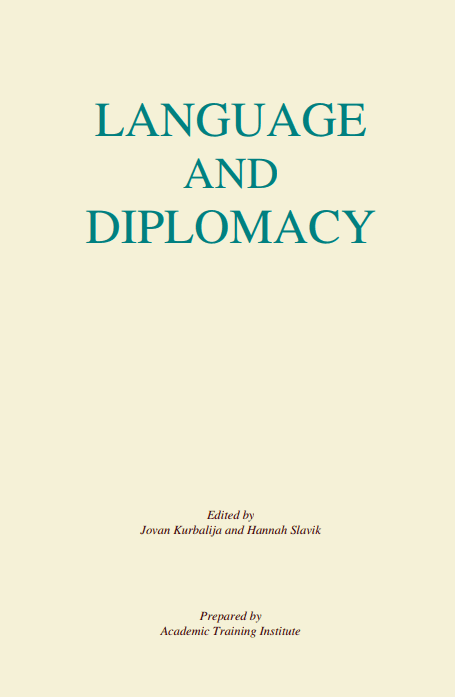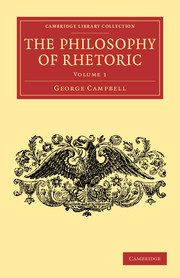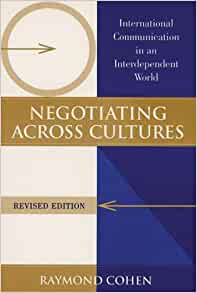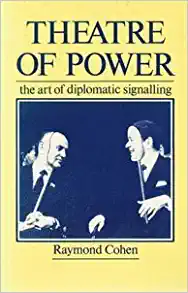Language and Diplomacy
2001
Contents
Preface: Jovan Kurbalija and Hannah Slavik
- To Joke or Not To Joke: A Diplomatic Dilemma in the Age of Internet – Peter Serracino-Inglott
- Use of Language in Diplomacy – Stanko Nick
- Language and Diplomacy – Kamel S. Abu Jaber
- Language and Diplomacy – A Practitioner’s View – Aldo Matteucci
- Language and Negotiation: A Middle East Lexicon – Raymond Cohen
- Talking to Americans: Problems of Language and Diplomacy – Paul Sharp
- Language, Signaling and Diplomacy – Kishan S. Rana
- Historical Rhetoric and Diplomacy – An Uneasy Cohabitation – Drazen Pehar
- Language Setting the Stage for Diplomacy; Diplomacy Based on Interpretation, Rhetoric and Ethics; Philosophical Considerations – Benoit Girardin
- Ambiguity Versus Precision: The Changing Role of Terminology in Conference Diplomacy – Norman Scott
- Use of Ambiguities in Peace Agreements – Drazen Pehar
- Texts in Diplomacy – Dietrich Kappeler
- Documenting Diplomacy, Evaluating Documents: the Case of the CSCE – Keith Hamilton
- Pragmatics in Diplomatic Exchanges – Edmond Pascual
- Deconstruction and the Undoing of Diplomacy: A Case Study Involving the Vienna Convention on Diplomatic Relations – Ivan Callus and Ruben Borg
- The Languages of the Knights: Legislation, Administration and Diplomacy in a Multilingual State (14th-16th Centuries) – Joseph M. Brincat
- Applying the Pedagogy of Positiveness to Diplomatic Communication – Francisco Gomes de Matos
- Setting Priorities for a World Language Initiative – Donald F. Sola
- Interpretation and Diplomacy – Vicki Ann Cremona and Helena Mallia
- Hypertext in Diplomacy – Jovan Kurbalija
You may also be interested in

Language and Diplomacy
Part of Language and Diplomacy (2001): Dr Abu Jaber brings a cross-cultural element to the discussion of language and diplomacy, surveying the historical development of diplomatic language particularly in the Arab world. However, he points out that the very idea of a language of diplomacy "is that it should not be culture-bound but an attempt at transcending such boundaries to create a quasi neutral vehicle of exchange." Abu Jaber notes that the language of diplomacy has to this date not been successful in resolving violence between nations and peoples. Yet he believes that solutions to violen...
On intercultural training of diplomats
Today the world is becoming smaller and smaller - distances shrink and become irrelevant, information flows are immense and very fast. People tend to speak foreign languages and, to their surprise, find out that this is not enough. There is more to it, and it is culture. It is of paramount importance to educate a generation of people capable of communicating effectively and working together with representatives of other cultures.

Intercultural communication in Macedonia: Different people, different stories
This papers examines how the Macedonians and the Albanians live in Macedonia. How do they communicate? Is there friendship everywhere? How do the two nations, live together, how do they communicate. The answer to this question coming from two different people may reveal two opposite viewpoints, the optimistic and the pessimistic. This paper focuses on communication between the Macedonians and the Albanians, considering that these are the two largest ethnic groups in the Macedona and even more, that these two groups were involved in the military conflict in 2001.

The languages of the Knights
Part of Language and Diplomacy (2001): In his examination of the languages used by the Knights of St John in Rhodes and Malta during the 14th to 16th centuries, Professor Joseph Brincat applies the methodology of historical linguistics. As an international and multi-lingual entity, the Order faced difficulties with its administrative methods intimately linked to linguistic issues.
Making the “other” human: The role of personal stories to bridge deep differences
How do negotiators and other conflict resolution practitioners from different cultures create shared understanding? Is shared understanding enough to bridge deep differences?

Diplomats as cultural bridge builders
Diplomats are people who are on the fringe somewhere, because they are either permanently living in or at least dealing with alien cultures, cultures with different values. The success of a diplomat depends on this brinkmanship because, on the one hand, they must remain credible with their superiors back home and, on the other hand, they must have access to the leaders in the country where they are posted. This paper discusses the role of diplomats as cultural bridge-builders.

Historical rhetoric and diplomacy – An uneasy cohabitation
Part of Language and Diplomacy (2001): Drazen Pehar writes about historical rhetoric; specifically the historical analogies used by diplomats and politicians to strengthen their arguments and convince others of their views. Using numerous historical and current examples, especially from the Balkans region, Pehar explains why historical analogies are used. He examines the role historical analogies often play in worsening relations between nations and bringing about conflict.

Talking to Americans: Problems of language and diplomacy
Part of Language and Diplomacy (2001): Professor Paul Sharp discusses negotiation with American mediators. He notes that most literature on negotiation is written to advise Americans and other Westerners about negotiating with foreigners.

Language, culture and the globalisation of discourse
To explore the idea that word use is culture-bound, this paper examines the English words culture and globalisation, to discover how they are used, and how they have come to have certain meanings or represent certain ideas.

Who are diplomats?
Many remember Ivo Andric for his Nobel Prize for Literature. He is also remembered as a diplomat with over 20 years of experience. In his note on diplomacy, published here for the first time in English with the kind permission of the Andric Foundation, Andric describes who the diplomat is, and the qualities that those devoting themselves to diplomacy ought to have.

Language, signaling and diplomacy
Part of Language and Diplomacy (2001): Ambassador Kishan Rana introduces the dimension of diplomatic signalling. Beginning with a reference to the Bhagwad Gita, one of the sacred texts of the Hindus, Rana outlines the qualities of good diplomatic dialogue: not causing distress to the listener, precision and good use of language, and truthfulness.

Framing an argument
Dr Biljana Scott’s article on framing an argument introduces the linguistic and rhetoric aspects of persuasion. The way in which we frame an issue largely determines how that issue will be understood and acted upon. By dissecting Obama’s Nobel Prize acceptance speech of December 2010, Dr Scott illustrates the main techniques for framing an argument.

Interpretation and diplomacy
Part of Language and Diplomacy (2001): Conference interpreters Vicky Cremona and Helena Mallia outline the different types of conference interpretation, difficulties in interpretation, preparation and techniques, and team work. On the topic of diplomatic conferences they point out that "confidence in the interpreters is essential.

Knowledge management and international development – the role of diplomacy
In this chapter, Walter Fust talks about the role of knowledge management, and knowledge for development, in diplomacy. He describes various methods to assess what knowledge should be stocked, and explains the need for managers who are assigned the task of deciding what should be stocked. These decisions need to be guided by principles, or guidelines - referred to as value management.

To joke or not to joke: A diplomatic dilemma in the age of internet
Part of Language and Diplomacy (2001): The first paper, presented by Prof. Peter Serracino-Inglott as the keynote address at the 2001 conference, examines the serious issue of diplomatic communication in a playful manner, through one of the most paradigmatic and creative examples of language use: joking.

Documenting diplomacy, Evaluating documents: The case of the CSCE
Part of Language and Diplomacy (2001): Rather than individual documents, Dr Keith Hamilton looks at the process and purpose of compiling collections of documents. He focuses on his own experience as the editor of Documents on British Policy Overseas, and particularly on his work publishing a collection of documents concerning the Conference on Security and Cooperation in Europe from 1972 until 1975.

Philosophy of Rhetoric
The author introduces a series of Essays on Rhetoric, explaining their origins and interconnection. This work has been a lifelong pursuit since 1750 and is structured based on a plan laid out in the first two chapters.

Lessons from two fields
A conversation between a diplomat and an interculturalist, combining real-life examples from the diplomatic field with intercultural theory.
Theories of persuasion and psychology: the power of situations
Throughout its history, humankind has been motivated to war, terrorism, ethnic cleansing, genocide, racist hysteria, religious intolerance and extremism, mass suicide and many other forms of irrational and pathological behaviour. The problem arises as Milan Kundera defines it, when we ask that terrible anthropological question – ‘What are people capable of’?

Diplomatic language and translation. Case study: President Donald Trump’s rhetoric
This thesis explores the importance of diplomatic language, persuasive rhetoric and translation in international diplomacy. The hypothesis here is that diplomatic language is changing and that this change affects both our understanding and use of language and linguistic devices. In order to exemplify this trend, a case study analyses President Donald Trump’s controversial rhetoric and its translatability. The thesis provides, first, a close reading of texts that illustrate the pervasive power of a politician’s style, rhetoric and persuasiveness. Second, it considers the translation challen...

Use of ambiguities in peace agreements
Part of Language and Diplomacy (2001): Drazen Pehar looks specifically at the use of ambiguities in peace agreements. Pehar explains why ambiguities are so often used and why diplomats and others involved in international relations may think it best to eliminate ambiguities from peace agreements altogether.

Leaders’ rhetoric and preventive diplomacy – issues we are ignorant about
In this paper, Drazen Pehar analyses the argumentation made by George Lakoff of the University of California at Berkeley in his seminal paper on ‘Metaphor and War’, in which he tried to deconstruct the rhetoric U.S. president George Bush used to justify the war in the Gulf. He also analyses a reading by psycho-historian Lloyd deMause, whose theory differs from Lakoff’s. Throughout his analysis, Pehar describes the role of rhetoric in diplomatic prevention of armed conflicts, and its several functions, and concludes that the methods of preventive diplomacy depend heavily on the theory of...

Texts in diplomacy
Part of Language and Diplomacy (2001): Professor Dietrich Kappeler provides an overview of the various types of formal written documents used in diplomacy, pointing out where the practices surrounding these documents have changed in recent years. He also discusses multi-language treaties, including the difficulties of translation and interpretation.

Deconstruction and the undoing of diplomacy
Part of Language and Diplomacy (2001): Ivan Callus and Ruben Borg apply a very different set of tools to the analysis of diplomatic discourse. Their paper applies the discourse of deconstruction, a form of literary criticism, to the Vienna Convention on Diplomatic Relations.

Setting priorities for a ‘world language’ initiative
Part of Language and Diplomacy (2001): Dr Donald Sola asks whether software innovation can make a contribution to the needs of those learning the world "languages of wider communication". He presents his work in developing computer-assisted language learning software, a multi-disciplinary activity not based simply on technology but also on the theory and practice of education and linguistics.

Multiculturalism for the masses: Social advertising and public diplomacy post-9/11
The terrorist attacks of 9/11 have brought an old problem into new focus: how to unite a population potentially divided along racial, ethnic and denominational fault lines. In the light of unprovoked and indiscriminate racist attacks on Muslim-looking minorities, multi-media advertising campaigns were mounted in several countries in order to quell racism and sell multiculturalism. This paper examines the use of advertising campaigns as a medium for public diplomacy, and focuses on the promotion of national unity out of cultural diversity.
Do the Experts Mean What Their Metaphors Say? An Exploration of Metaphor in Mediation Literature
The message explores the use of metaphor in mediation literature to determine if experts truly align with what their metaphors suggest.

Language and Diplomacy: Preface
Part of Language and Diplomacy (2001): In the preface below, Jovan Kurbalija and Hannah Slavik introduce the chapters in the book, and extract the general themes covered by the various authors.

Negotiating across cultures
The text is about the importance of understanding cultural differences in negotiations. It highlights the need for awareness of varying communication styles, etiquette, and values when engaging in cross-cultural negotiations. By acknowledging and respecting cultural nuances, negotiators can build trust, establish rapport, and achieve successful outcomes in diverse settings.

Language and negotiation: A Middle East lexicon
Part of Language and Diplomacy (2001): Professor Raymond Cohen writes that "when negotiation takes place across languages and cultures the scope for misunderstanding increases. So much of negotiation involves arguments about words and concepts that it cannot be assumed that language is secondary." With numerous examples of the culturally-grounded references, associations and nuances of certain words and phrases in English and the Middle Eastern languages (Arabic, Turkish, Farsi and Hebrew), Cohen introduces his project of developing a negotiating lexicon of the Middle East as a guide for condu...

The origins – where is the connection between persuasion and rhetoric?
As ancient rhetoricians believed that language was a potent force for persuasion, they insisted that their students develop copia in all spheres of their art. Copia denotes an abundant and ready supply of language in any situation that arises. Why did ancient teachers of rhetoric insist on this practice? Well, they knew that training their students in different rhetorical arts prepared them for the multitude of communicative and persuasive possibilities that exist in language.

Through the Diplomatic Looking Glass
This study presents and analyses books published by Italian diplomats. The more than seven-hundred and fifty titles listed give a broad and varied picture of diplomats and the diplomatic world. This volume evokes not only the talent for describing situations and characters, but also the broad, diverse interests that distinguish the members of this profession. As well, this study takes a broader view of relations between diplomacy and literature, examining the primary moments and protagonists of this relationship.

Ambiguity versus precision: The changing role of terminology in conference diplomacy
Part of Language and Diplomacy (2001): Of central concern in the field of negotiation is the use of ambiguity to find formulations acceptable to all parties. Professor Norman Scott looks at the contrasting roles of ambiguity and precision in conference diplomacy. He explains that while documents drafters usually try to avoid ambiguity, weaker parties to an agreement may have an interest in inserting ambiguous provisions, while those with a stronger position or more to gain will push for precision.

Applying the pedagogy of positiveness to diplomatic communication
Part of Language and Diplomacy (2001): Dr Francisco Gomes de Matos applies what he calls the "Pedagogy of Positiveness" to diplomatic communication. He proposes a checklist of tips for diplomats to make their communication more positive, emphasising respect and understanding of the other side, and keeping in mind the ultimate goal of avoiding conflict.

Language: Setting the stage
Part of Language and Diplomacy (2001): Benoit Girardin takes a philosophical approach to rhetoric - along with the issues of interpretation and ethics. He examines each of these three fields and its relation to diplomatic practice and negotiations, showing with examples how diplomatic language exhibiting either a lack or an excess of any of these qualities may lead to problems.
Metaphor and War: The Metaphor System Used to Justify War in the Gulf
The text discusses how metaphors are used to justify war in the Gulf.

Intercultural Communication and Diplomacy
Intercultural Communication and Diplomacy is a collection of papers presented at two conferences: the 2003 Conference on Intercultural Communication and Diplomacy, and the 2004 Conference on Organisational and Professional Cultures and Diplomacy.

Persuasion: bad practices and … others
Persuasion is a very relative concept. Like beauty, persuasion is the eye of the beholder. Admittedly, persuasion does not exist in the absence of results. One can say that persuasion can be defined as such, if and only if it is effective and reaches its goals. If we accept this prerequisite, we may find persuasion where we least expect it.

DiploDialogue – Metaphors for Diplomats
On Diplo’s blog, in Diplo’s classrooms, and at Diplo’s events, dialogues stretch over a series of entries, comments, and exchanges and may even linger. DiploDialogue summarises. It’s like in sports events: DiploDialogue aims to bring focus by deleting what, in hindsight, is less relevant. In this first DiploDialogue, Katharina Höne and Aldo Matteucci discuss the usefulness of analogies and metaphors for understanding international relations and diplomacy.

Pragmatics in diplomatic exchanges
Part of Language and Diplomacy (2001): Edmond Pascual interprets diplomatic communication with the linguistic tools of pragmatics. He begins by reminding us that while the diplomat is a "man of action," the particular nature of the diplomat's action is that it consists of speech. Pascual applies three concepts of pragmatics to diplomatic discourse: speech as an intentional act; the effects of the act of speech; and the role of the unsaid in the act of speech.

Cultural content on the websites of diplomatic systems
The text discusses the importance of including cultural content on diplomatic systems' websites to promote understanding and build relationships between countries.

Language and Diplomacy
Language and Diplomacy is a collection of papers presented at the February 2000 Second International Conference on Knowledge and Diplomacy and the January 2001 Conference on Language and Diplomacy. The book examines traditional aspects of language in diplomacy: diplomatic signaling, rhetorical patterns and ambiguities; as well as new issues raised by information technology. The publication is available online.

Language and Power
The text discusses the relationship between language and power, highlighting how language can be used to manipulate and control individuals and societies. It explores how those in power often dictate the norms and values through language, influencing perceptions and behaviors. The text also emphasizes the importance of recognizing and challenging power dynamics embedded in language to promote equality and social change. Language is portrayed as a tool that can both reinforce and challenge power structures within a society.

An intercultural model for diplomacy training in New Zealand
This paper develops a model of diplomacy training based on intercultural competence and situated learning and applies the model to intercultural encounters.

Challenges facing women in overseas diplomatic positions
This paper identifies challenges that women face when working overseas in diplomatic positions, a professional environment that historically has been male dominated and that can be characterised in some ways as an 'old boys' network. It identifies some of the significant issues from the perspective of women who are serving or have served their countries’ foreign missions.

Internet governance and service provision in Zimbabwe
From an Internet governance perspective, multilingualism and security have been two of the cornerstone themes since its inception. The security theme addresses topics regarding the Domain Names System (DNS), Public Key Infrastructure (PKI), Internet attacks, security awareness, and policies and legal measures to ensure a safe and secure Internet experience. Security is a very diverse area where multiple topics should be tackled, and ignoring one or more topics while securing other areas would still jeopardise the safety of Internet users.

Intercultural competence and its relevance for international diplomacy
The changing nature of international diplomacy requires new knowledge and awareness of intercultural and other skills needed to perform effectively in the role of diplomat. The research presented in this paper serves to inform current and future planning for the selection, training, and evaluation of international diplomats.

A practitioner’s view
Part of Language and Diplomacy (2001): With examples from a detailed case study of the historical New Zealand Treaty of Waitangi, Aldo Matteucci shows us that the diplomat's job is to decode language. Matteucci writes that all language comes with "hidden baggage": hidden meanings and intentions, historical and political context, legal precedents, etc. In order to find these hidden meanings the diplomat needs a broad understanding of the context of a situation.

Misunderstood: The IT manager’s lament
Communication between information technologists and their clients – including diplomats - does not work as well as it should. We know that information technology has become ubiquitous. We also know that diplomats rely extensively on web services, electronic mail and documents in electronic form. Yet when communication does not work well, technologists poorly understand the needs of the diplomatic community. As a result, technical solutions may not address the real needs of end-users. This paper is a study on inter-professional miscommunication.

Hypertext in diplomacy
Part of Language and Diplomacy (2001): The final paper in this volume, by Jovan Kurbalija, is based on the experience of ten years of research and development work in the field of information technology and diplomacy. Kurbalija explains the relevance and potential of hypertext software tools for the field of diplomacy.

Use of language in diplomacy
Part of Language and Diplomacy (2001): Ambassador Stanko Nick takes a practical approach, examining issues such as the choice of language in bilateral and multilateral meetings, the messages conveyed by language choice, difficulties posed by interpretation, and aspects of diplomatic language including nuance, extra-linguistic signalling, and understatement. Language, according to Nick, is not a simple tool but "often the very essence of the diplomatic vocation."

Communication barriers to negotiation: Encountering Chinese in cross-cultural business meetings
When two negotiating parties from different cultural backgrounds attempt to communicate, the potential for disagreement and misunderstanding is great. People from other cultural backgrounds, especially from the West, often find the behaviour of Chinese negotiators strange and unintelligible. This paper examines communication barriers between Chinese, Australian and American negotiators.

To Begin the World Anew: The Genius and Ambiguities of the American Founders
When I feel dispirited about the current crop of political leaders in Switzerland or around the world, I like to take refuge in one of the most uplifting political stories of mankind – the American Revolution.

International domain names from a multilingualism and security perspective
From an Internet governance perspective, multilingualism and security have been two of the cornerstone themes since its inception. The security theme addresses topics regarding the Domain Names System (DNS), Public Key Infrastructure (PKI), Internet attacks, security awareness, and policies and legal measures to ensure a safe and secure Internet experience. Security is a very diverse area where multiple topics should be tackled, and ignoring one or more topics while securing other areas would still jeopardise the safety of Internet users.

Jargon, protocols and uniforms as barriers to effective communication
This paper presents a number of case studies illustrating the role of jargon, protocols and uniforms in creating communication problems. The authors provide some pointers for improving communication and are conscious of the fact that in the five thousand years of recorded history, extensive research in philosophy, biology, sociology, psychology and other disciplines has offered few answers to the problems of effective communication across cultures and professions. However, some measures do work, when there is a will from all parties for them to work.

Theatre of Power: The Art of Signaling
Theatre of Power: The Art of Signaling discusses how strategic signaling plays a vital role in navigating power dynamics. Leaders can use various techniques to convey strength and influence, such as body language, attire, and other symbols. Mastering the art of signaling can help individuals assert dominance and command respect in various settings.
Summitry as intercultural communication
In one of his last essays before his premature death in 1972, Martin Wight described international conferences as ‘the set pieces punctuating the history of the European states-system, moments of maximum communication’.
The latest from Diplo and GIP
Tailor your subscription to your interests, from updates on the dynamic world of digital diplomacy to the latest trends in AI.
Subscribe to more Diplo and Geneva Internet Platform newsletters!
Diplo: Effective and inclusive diplomacy
Diplo is a non-profit foundation established by the governments of Malta and Switzerland. Diplo works to increase the role of small and developing states, and to improve global governance and international policy development.


